Windbound – Review – Nothing below the surface
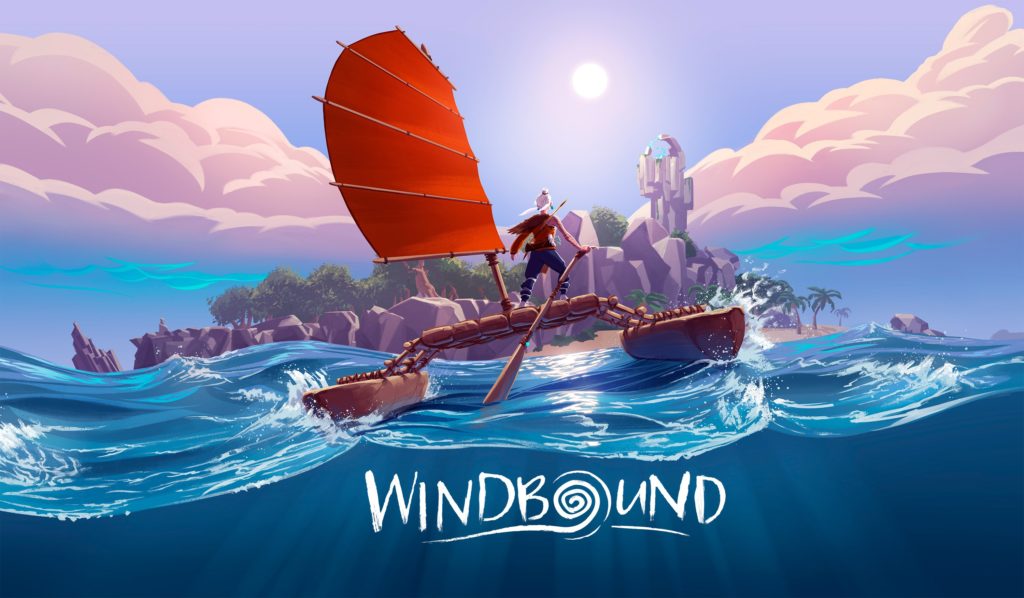
Windbound is a survival game with a side of narrative, a procedurally generated island-hopper built off the back of some extremely enjoyable wave-physics that collide with some extremely tedious survival mechanics.
It’s a gorgeous game, with bright colours and a distinctive aesthetic — I’ve seen it described as “Moana meets Breath of the Wild” which might misunderstand both of those titles. But it’s pretty nonetheless.
But before I’d actually started a game of it — after I’d selected my profile, but before the opening cutscene — Windbound had me feeling offside.The first thing the game does is present you with a difficulty option, and from the description of that alone I felt unwelcome.
Open Your Eyes, Let’s Begin
The default difficulty, Survivalist, or playing ‘the full Windbound experience” — is essentially an Iron Man or Hardcore difficulty. Windbound wants you to learn how to play it while permadeath is on the table.
It’s not exactly permadeath, I suppose. You get to keep whatever is ‘in your hands’, which adds up to a whopping seven items. But outside of those items, you’re done. You start the game anew at the first Chapter. Even before I had begun this seemed a bit much.
But I opted to play on Survivalist anyway. I wanted the full Windbound experience. And truth be told, the opening of the game felt good. It felt like a classic Survival game. It reminded me a lot of Raft, another game where a few planks of wood are the difference between life or death.
Survival games are all about learning. The artificially high stakes lead to quick problem-solving, and the experiential learning process leads to — in some people, anyway — high retention of in-game skills. It’s why I only play Minecraft every other year but I can still build my way up to a Nether Portal (I assume those still exist) from memory — because the way survival games teach players bakes that knowledge into their brain. Years from now, when decades of drinking have reduced my brain to a shrivelled peanut, you’ll find me muttering “Jellyshroom Cave” as the location of Magnetite in Subnautica is the only object left unbroken in my mind palace.
And in Windbound, the loop seems to exist at the start. You wake, washed ashore, on an island the size of an indoor cricket court, and the first thing you do is take stock. You’ve got a knife, a health bar and a stamina meter. And the stamina meter is slowly degrading thanks to hunger.
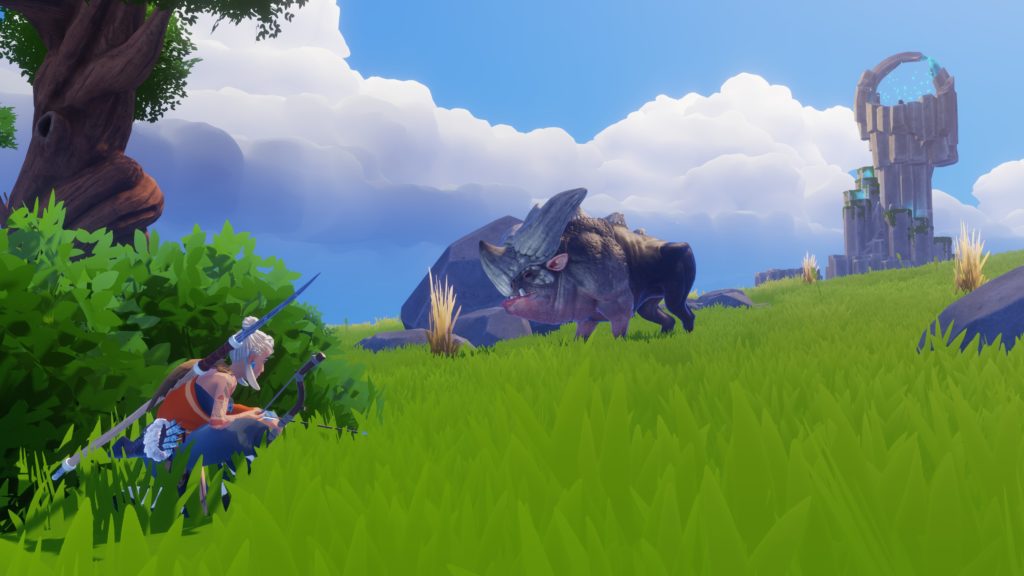
The island you’re on has grass you can cut with your knife, which you can turn into rope. And sticks you can bind together into a canoe. There are berries to eat and pigs to spear. Rocks to pick up and sling. And at the far end of the island there’s an altar holding an oar. With the oar, you can build a canoe. And suddenly the rest of the game world opens up.
As you paddle your way to new islands you discover large beasts, many of which are capable of killing you in just a few blows. The combat, like the rest of Windbound, has spectacular ideas that are held back by some iffy execution. Headshots, for example, do critical damage, so it’s in your best interest to put yourself in harm’s way while you try to do them. But the lock-on mechanic — Left Trigger — makes you move extremely slowly, and often targets slower than some enemies move. So you put yourself in danger only to find your gambit has failed, and you’ll take some unearned damage as a result.
Honestly I can go on and on
And because the cost of death is so high, that unearned damage is felt so much more. It makes the process of engaging in melee combat essentially unviable. You can’t even dodge if you’re not locking on to a target, so closing the distance with any enemy is just a recipe for disaster.
Worse, when you do kill these big beasts, you’ll find that by-and-large it wasn’t worth it. With the Gloomharrow skin you can make stealth armour, but… why would you do that? What’s the point? The only enemies that might see you before you see them are so inconsequentially simple to deal that it doesn’t matter if you stealth past them. Hell, because Hunger bleeds your stamina at such a fast rate and because food degrades in quality — there’s weapon and item degradation in Windbound — you’re probably running around trying to pick a fight with these tiny hopping mouths anyway. You need the meat.
Or you might make a shovel, or a hammer with those Gorehorn Crests. That way you can dig up clay, which you can use to… make nothing of any import. Or mine metals that will allow you to… do nothing you couldn’t manage already.
It feels like you wind up discovering things purely for the sake of it — exploration in the Sir Edmund Hilary sense, but without the accompanying sense of achievement. Each new island you visit presents you with new opportunities to learn about this world, but the reality is that Windbound isn’t all that deep.
The game is split by chapters, a method used to both incentivise exploration and as a cover to generate new terrain. As you explore each chapter’s map, you’ll find three altars, altars not unlike the one bearing your oar. You climb them, a beacon lights, you absorb a snail or something and you move on.
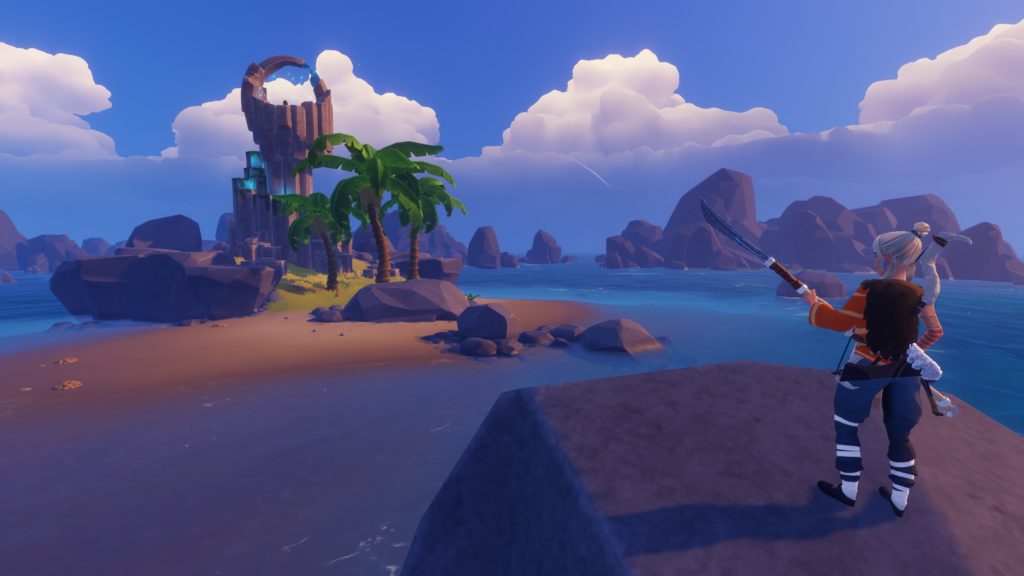
If it is a rendition of the Far Cry style “Radio Tower” objective — and I believe it is — it’s lacking. The Radio Towers unveiled the map for players, showcasing the (honestly overwhelming) amount of objectives available to them in close proximity. Here, the altars exist only as gates. They uncover nothing. They appear to be critical to the story (if I interpreted the ending correctly) but outside of that the only reason you do them is because you are required to in order to proceed.
If you don’t hit all three altars on your way to the end-of-chapter location, the bridge mechanisms leading to the end will not open up. That’s it — that’s your incentive to find the altars. For the game, they provide a much needed time-sink. According to Steam it took me around 11 hours to finish Windbound. It could have been a lot shorter, except for a stack of unearned setbacks.
What’s the lesson? What is the take-away?
My first death in Windbound came when I slipped off a rock and fell. As a person with more than 1000 hours in DayZ I’m no stranger to rock-related injuries, but this one stung — I was sent back to the start of the game with just the seven garbage items I was holding. My boat was gone, the items in my backpack gone… the backpack itself gone. I was not quite back at square one, but I was damn close.
I dropped the difficulty level immediately.
My next setback came on the journey between chapter one and two, when the waves shoving my little raft along spiked me into the water. This in itself wasn’t too bad — it would wind up doing this about forty times before the game ended, some physics anomaly I can’t work out — but when my boat flipped itself back over again, my player character was stuck in the raft. That is to say, she was physically trapped, half her body above the raft platform and the half below it, like some Transporter mishap on Star Trek. Again, this in itself wasn’t a huge problem, and would wind up happening a dozen or so times before the game ended — but in this circumstance, my boat careened into a rock and smashed itself until I was free of the platform. And with the boat went a bag rack holding all of my most treasured items.
Another setback came when a Crabster — a small jumping crab thing that leaps off reefs onto your boat and attacks it — leapt aboard my craft and smashed it to pieces. The problem was it should have died when I hit it with my spear, but for whatever reason my attacks weren’t hitting it. All I lost in that instance were the resources required to build the boat part and a fire, but it shouldn’t have happened.
And my final major setback came when a giant worm attacked me from beneath the sand, and my player character fell into an animation cycle that meant I wasn’t able to run away from it to get to safety. On Story mode — which is what I had dropped it to — the worm required four hits to kill me, but that’s a cinch when your character is running on the spot going nowhere. Having changed to easy mode, all I lost was my boat and everything on it. And all progress I’d made in the final chapter of the game — I was literally on my way back to the boat to hit the end credits.
Obviously bugs happen. But when they happen in games that are as punishing as Windbound, it’s hard to forgive them. I still haven’t gotten over the Bed of Chaos boss fight in Dark Souls, which seems to be built from the ground up around the idea of unearned death. People hate dying to lag spikes in games, or glitchers, or hackers, because all of these deaths come to players who were ostensibly doing everything correctly.
And it feels like Windbound, which prides itself on its punishing difficulty, leads to a lot of these.
I harnessed the breeze
Worse still is that it’s at its jankiest in the best part of the game. The boating aspect of Windbound is where the game becomes a joy to play. The wave simulation system at work in Windbound makes me yearn for a surfing game, a game where the player does all they can to maximise their time on a rolling wall of rushing water.
Because Windbound allows you to feel that exact same rush multiple times. Getting up enough speed to just barely outpace a wave as it rolls over a reef and then steering your boat gently left and right to catch as much of the wave as possible as you go is about as good as it gets in Windbound. If you told me the game was conceived after a 5 Lives Studios sea-kayaking trip, I wouldn’t be surprised at all.
There’s a thrill in barely keeping your boat upright as the wind tries to drag you over with it, or as waves five times your height tower over you. And certainly the bugs that lead to your unearned setbacks mute this feeling somewhat, but there’s still no question that the best of Windbound is when you’re out at sea.
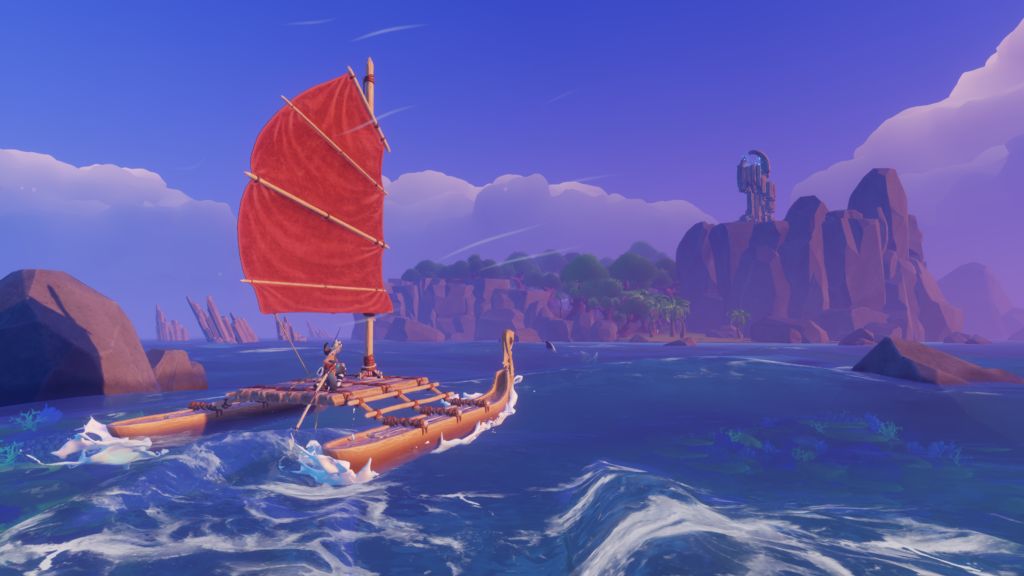
Again, though, Windbound runs into problems with its systems.
If we look at survival games as priority lists (and lord knows I do) then mastery of them comes from gear that removes tasks from the list. If I need to carry three objects and I am naked, then I need to carry two of them, place them down, return for the third and then catch up to my items again. If I create a holder for the third, I can eliminate a task (returning to the item) and my character progression is demonstrated for all to see.
Lots of survival games do this. In The Forest you can grow food and catch water to eliminate the task of scavenging for these things. In Subnautica you can build a SeaMoth to extend your oxygen reserves and your capacity for depth — and that’s just the start of the systems for those priorities.
In Windbound, you can build a fire to cook meat, and you can upgrade that fire to cook more meat at one time. You can build a rack to hold a backpack, you can extend the length and breadth of your raft to turn your boat into a moving base. And, as suggested by the name, you can build a sail to catch the wind and you can remove the need for the player to paddle.
When it works, sailing is awesome. Your sail stretches taut around its frame and your raft is yanked along by invisible strings, white curling lines flitting along behind you to showcase the current direction the wind is moving.
But too often the wind is not with you, and your raft will sit still, dead in the water. Your task then is to angle your craft against the wind, catching whatever you can in an effort to gain a little momentum and move towards your objective. It’s like the tedious opposite of trying to find the perfect line down a wave — instead of eking out a little extra distance as you flow towards your goal, you’re clawing and fighting to make any ground at all.
It flies in the face of the mastery concept of survival games. It is, in fact, less work to not build a sail on your watercraft. Sure, you have to paddle, but paddling is easy. There’s no brain function required. As long as you hold down the right trigger you will paddle in a straight line no matter what. With the correct application of rigor mortis you could paddle while dead.
You couldn’t sail while dead. Sailing requires constant attention. You need to angle for optimal speed. You need to chart a course between obstacles that takes into account the bearing of the wind. And you need to account for the fact that, to the best of my knowledge, the sea beasts of Windbound will only attack you if you have a sail.
I can’t confirm this for certain. I’m not 100% sure. But when I died in Chapter Five, literally minutes from finishing the game, I respawned at the beginning of the chapter (thanks Story difficulty!) on an island. My boat was gone. And when I built a new one, I opted to stick with the paddle only. It was slower, but it was better. And, as I said, the larger sea monsters no longer attacked me or my boat.
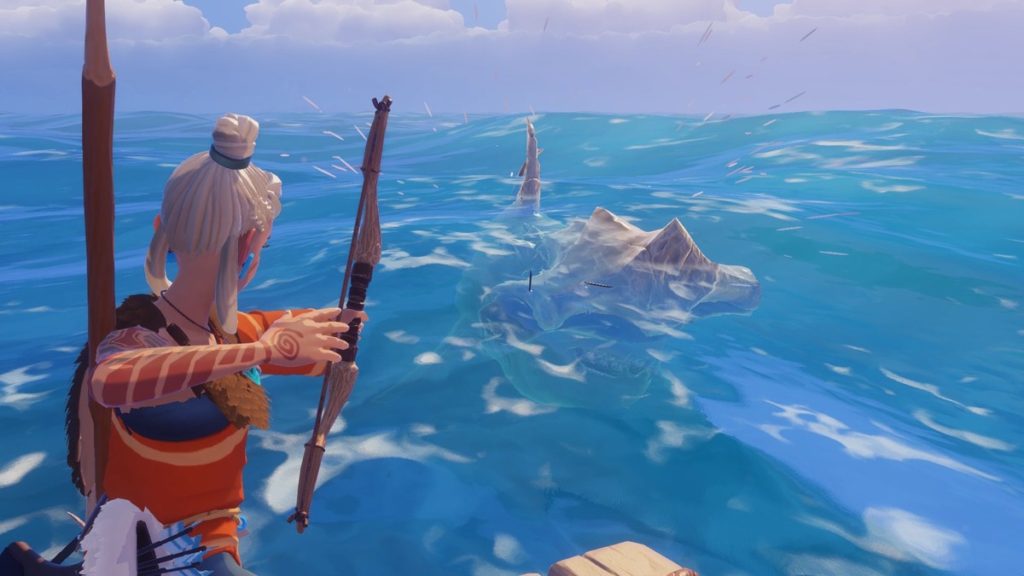
What can I say, except you’re unwelcome
It seems weird to me that the sail feels optional in a game called Windbound. Worse — the sail feels like a sub-par option.
But then, it’s sort of the story of Windbound’s entire survival-based progression mechanic. The narrative-focused progression is fine — a severely understated story that is rather pointlessly gated in a manner that I feel deliberately slows the player without really leading to further enlightenment, but fine.
But the survival progression, over and over, leads to the overwhelming feeling that the player might have been better off not bothering in the first place. In Windbound, finally getting the materials needed to build that sail eventually lead to me opting to not use it. Finally building a shovel after killing a beast I might have left alone otherwise made me wonder why I’d bothered. I repeatedly found myself wondering why I’d done things in the first place. I know the answer — curiosity.
That’s Windbound to a tee. By the end, you wind up doing things just to see what happens. You know, in your heart, that you don’t need to do them. You don’t need to kill that sea monster, that giant pig, that poison frog. But you do it anyway to find out what they drop. You visit that island to see what it holds. You antagonise that giant worm to see what it looks like (and then die thanks to an animation bug). When you do, you feel either apathy at the breadth of your discovery or anguish at the depth of your unearned death.

